Study on Failure Characteristics and Acoustic Emission Laws of Rock-like Specimens under Uniaxial Compression
Abstract
:1. Introduction
2. Materials and Methods
2.1. Proportioning Scheme of Rock-like Specimen
2.2. Preparation of Rock-like Specimens
- (1)
- Disassemble the mold, evenly apply lubricating oil on the inner surface of the mold to facilitate later demolding, and then assemble the mold.
- (2)
- Weigh the material according to the predetermined material proportion, thoroughly blend it, incorporate a specific quantity of water, and agitate until homogenous.
- (3)
- The mixed material is divided 5 times into the mold. Each filling requires shaking and compacting the concrete within the mold, followed by a final smoothing of the specimen surface.
- (4)
- After standing at room temperature for 24 h, the specimen is removed from the mold, assigned a number, and then cured for 28 d.
- (5)
- Select the specimen with smooth surfaces and a good forming effect, measure the size of the specimen, and grind the end of the specimen to ensure that the non-parallelism between the two ends of the specimen is within 0.05 mm.
- (6)
- The specimen undergoes ultrasonic testing, and select specimens with small dispersion.
2.3. Experimental System and Loading Method
3. Results and Analysis
3.1. Stress–Strain Curve Analysis
- (1)
- Pore and crack compaction stage: with the increase of axial compression, the original pores and cracks in the specimen were gradually closed, the material was compacted, and the stress–strain curve was concave downwards.
- (2)
- Elastic deformation stage: the stress–strain curve gradually approached a sloping straight line as the loading process continued. At that time, the slope of the straight line was the elastic modulus of the rock-like materials.
- (3)
- Damage stage: at this stage, new cracks and fissures were generated inside the rock-like specimens and the specimen produced irreversible deformation. The stress–strain curve was no longer a sloping straight line, and the slope of the curve gradually decreased.
- (4)
- Post-fracture stage: as the loading continued, the load that the rock-like specimen could withstand reached the peak value. At that time, the stress–strain curve suddenly dropped, and the specimen failure entered the post-fracture stage.
3.2. Analysis of Strength Characteristics
3.3. Failure Characteristic
3.4. Acoustic Emission Analysis
4. Conclusions
- (1)
- The rock-like specimens made of quartz sand, cement, and gypsum can simulate the rock mass in actual engineering, and the mechanical properties and failure process of the two have high similarity.
- (2)
- When the material is made of quartz sand–cement, the strength of rock-like specimens is positively correlated with the proportion of cement, the brittleness of the material is obvious, and it can simulate hard rock materials. When gypsum is added, the strength of the rock-like material significantly decreases, exhibiting a strong negative correlation with the proportion of gypsum.
- (3)
- The rock-like specimens made of quartz sand and cement show splitting failure characteristics after uniaxial compression, and the surface cracks of the specimens are less. When gypsum is added to the rock-like specimen, shear failure is the main failure after uniaxial compression, and there are many secondary cracks between the primary cracks on the specimen surface.
- (4)
- The maximum value of the acoustic emission ringing count is positively correlated with cement content and negatively correlated with gypsum content. The change in acoustic emission cumulative counts roughly goes through four stages, which have a good correspondence with the initial compaction stage, elastic stage, damage stage, and post-failure stage of typical rock uniaxial compression failure.
Author Contributions
Funding
Institutional Review Board Statement
Informed Consent Statement
Data Availability Statement
Acknowledgments
Conflicts of Interest
References
- Ma, C.; Yuan, Y.; Zha, J.; Li, H.; Xu, Y. Determine method of effective experimental period of similar material model for improving the simulation results. Energy Sources Part A Recovery Util. Environ. Eff. 2020, 1–10. [Google Scholar] [CrossRef]
- Tatone, B.S.A.; Abdelaziz, A.; Grasselli, G. Example framework for evaluation of synthetic rock-like materials as applied to a commercial gypsum cement. Int. J. Rock. Mech. Min. Sci. 2023, 169, 105445. [Google Scholar] [CrossRef]
- Li, H.; Guo, G.; Zha, J. Study on time-varying characteristics of similar material model strength and the regulation measures. Environ. Earth. Sci. 2017, 76, 518. [Google Scholar] [CrossRef]
- Lee, G.; Ryu, H.; Cho, G.; Kwon, T. Full-scale TBM excavation tests for rock-like materials with different uniaxial compressive strength. Geomech. Eng. 2023, 35, 487–497. [Google Scholar] [CrossRef]
- Klammer, A.; Peintner, C.; Gottsbacher, L.; Biermann, J.; Blümel, M.; Schubert, W.; Marcher, T. Investigation of the Influence of Grain-Scale Heterogeneity on Strain burst Proneness Using Rock-Like Material. Rock Mech. Rock Eng. 2023, 56, 407–425. [Google Scholar] [CrossRef]
- Shi, J.; Chen, Z.; Zheng, B. Experimental Research on Material and Mechanical Properties of Rock-Like Filling Materials in Disaster Prevention of Underground Engineering. Adv. Mater. Sci. Eng. 2021, 2021, 6691310. [Google Scholar] [CrossRef]
- Wu, B.; Huang, W. Uniaxial compression mechanical properties of rock samples in soft and hard composite strata. Adv. Mater. Sci. Eng. 2020, 2020, 5920348. [Google Scholar] [CrossRef]
- Shi, Y.; Ye, Y.; Hu, N.; Huang, X.; Wang, X. Experiments on material proportions for similar materials with high similarity ratio and low strength in multilayer shale deposits. Appl. Sci. 2021, 11, 9620. [Google Scholar] [CrossRef]
- Zhao, W.; Gao, H.; Chen, W.; Liu, J.; Peng, W.; Zhou, S. Experimental study on similar materials for tunnel lining concrete in geomechanical model tests. Eng. Fail. Anal. 2023, 152, 107456. [Google Scholar] [CrossRef]
- Zhan, K.; Xue, J. Development and Properties of a Similar Material to Coal. Energies 2022, 15, 6922. [Google Scholar] [CrossRef]
- Gao, P.; Wang, M.; Lei, X.; Zong, Q. Dynamic mechanics and crystal structure fracture characteristics of rock-like materials in Coal Mines. Minerals 2022, 12, 290. [Google Scholar] [CrossRef]
- Haeri, H.; Khaloo, A.; Marji, M. Experimental and Numerical Simulation of the Microcrack Coalescence Mechanism in Rock-Like Materials. Strength Mater. 2015, 47, 740–754. [Google Scholar] [CrossRef]
- Sabri, M.; Ghazvinian, A.; Nejati, H. Effect of particle size heterogeneity on fracture toughness and failure mechanism of rocks. Int. J. Rock. Mech. Min. Sci. 2016, 81, 79–85. [Google Scholar] [CrossRef]
- Sharafisafa, M.; Shen, L.; Xu, Q. Characterisation of mechanical behaviour of 3D printed rock-like material with digital image correlation. Int. J. Rock. Mech. Min. Sci. 2018, 112, 122–138. [Google Scholar] [CrossRef]
- Feng, G.; Fan, Y.; Wang, P.; Guo, J.; Wen, X.; Qian, R.; Zhu, L. Analysis of damage and failure process of rock like specimens under uniaxial compression under different material combinations and ratios. Chin. J. Rock Mech. Eng. 2023, 42, 3377–3390. [Google Scholar] [CrossRef]
- Kang, Y.; Gu, J.; Wei, M. Mechanical properties and acoustic emission characteristics of soft-hard interbedded rocks under different loading rates. J. Northeast. Univ. 2023, 44, 399–407. [Google Scholar] [CrossRef]
- Yin, P.; Yang, S. Experimental study on strength and failure behavior of transversely isotropic rock-like material under uniaxial compression. Geomech. Geophys. Geo-Energy Geo-Resour. 2020, 6, 44. [Google Scholar] [CrossRef]
- Kong, Y.; Ruan, H.; Wang, Z. Selection and mechanical properties testy of similar brittle rock-like model materials of basalt. Chin. J. Geotech. Eng. 2023, 45, 2308–2318. [Google Scholar] [CrossRef]
- Zhu, C.; An, Y.; Li, D. Research on crack process of similar materials coal sample under uniaxial compression. J. Min. Res. Dev. 2022, 42, 144–148. [Google Scholar] [CrossRef]
- Lu, H.; Zhang, K.; Yi, J.; Chao, W. A study on the optimal selection of similar materials for the physical simulation experiment based on rock mineral components. Eng. Fail. Anal. 2022, 140, 106607. [Google Scholar] [CrossRef]
- Grosse, C.; Ohtsu, M. (Eds.) Acoustic Emission Testing; Springer: Berlin/Heidelberg, Germany, 2008. [Google Scholar] [CrossRef]
- Carpinteri, A.; Lacidogna, G.; Accornero, F.; Mpalaskas, A.C.; Matikas, T.E.; Aggelis, D.G. Influence of damage in the acoustic emission parameters. Cem. Concr. Compos. 2013, 44, 9–16. [Google Scholar] [CrossRef]
- Aggelis, D.G. Classification of cracking mode in concrete by acoustic emission parameters. Mech. Res. Commun. 2011, 38, 153–157. [Google Scholar] [CrossRef]
- D’Angela, D.; Ercolino, M. Acoustic emission entropy: An innovative approach for structural health monitoring of fracture-critical metallic components subjected to fatigue loading. Fatigue Fract. Eng. Mater. Struct. 2021, 44, 13412. [Google Scholar] [CrossRef]
- Wang, Z.; Yang, Y.; Xu, Y.; Xin, C.; Liang, P.; Guo, N. Analysis of Energy Evolution and Acoustic Emission Characteristics of Rocks under Cyclic Loading and Unloading. Appl. Sci. 2023, 13, 10453. [Google Scholar] [CrossRef]
- Chen, Y.; Wei, Z.; Zhang, Q. Experimental study on Felicity effect of acoustic emission in rock under cyclic loading and tiered cyclic loading. J. China Coal Soc. 2012, 37, 226–230. [Google Scholar]
- Li, D.; Wang, E.; Kong, X.; Jia, H.; Wang, D.; Muhammad, A. Damage precursor of construction rocks under uniaxial cyclic loading tests analyzed by acoustic emission. Constr. Build. Mater. 2019, 206, 169–178. [Google Scholar] [CrossRef]
- Ou, J.; Wang, E.; Wang, X.; Wang, B.; Zhu, G. Acoustic emission characteristics and damage evolution of different rocks under uniaxial compression conditions. Sci. Rep. 2024, 14, 4179. [Google Scholar] [CrossRef]
- Rao, M.V.M.S.; Prasanna Lakshmi, K.J. Analysis of b-value and improved b-value of acoustic emissions accompanying rock fracture. Curr. Sci. 2005, 89, 1577–1582. [Google Scholar] [CrossRef]
- Xing, T.; Zhu, H.; Song, Y. Experimental Study on Rock Deformation Localization Using Digital Image Correlation and Acoustic Emission. Appl. Sci. 2024, 14, 5355. [Google Scholar] [CrossRef]
- Chen, A.; Dai, S.; Zhang, Y.; Huang, S.; Ye, Z. Study on size effect of damage evolution of cemented back fill. Chin. J. Rock Mech. Eng. 2019, 38, 3053–3060. [Google Scholar] [CrossRef]
- Zuo, J.; Pei, J.; Liu, J.; Peng, R.; Li, Y. Investigation on acoustic emission behavior and its time-space evolution mechanism in failure process of coal-rock combined body. Chin. J. Rock Mech. Eng. 2011, 30, 1564–1570. [Google Scholar]
- Long, D.; Wang, Y.; Li, C.; Wu, Y.; Hu, Y. Energy Mechanism and Acoustic Emission Characteristics in Rock-Backfill Composite Structure Specimens under Multi-Level Cyclic Loads: Cement-Tailings Ratio Effect. Minerals 2024, 14, 665. [Google Scholar] [CrossRef]
- Pan, J.; Yuan, S.; Jiang, T.; Cui, C. Experimental study on crack characteristics and acoustic emission characteristics in rock-like material with pre-existing cracks. Sci. Rep. 2021, 11, 23790. [Google Scholar] [CrossRef] [PubMed]


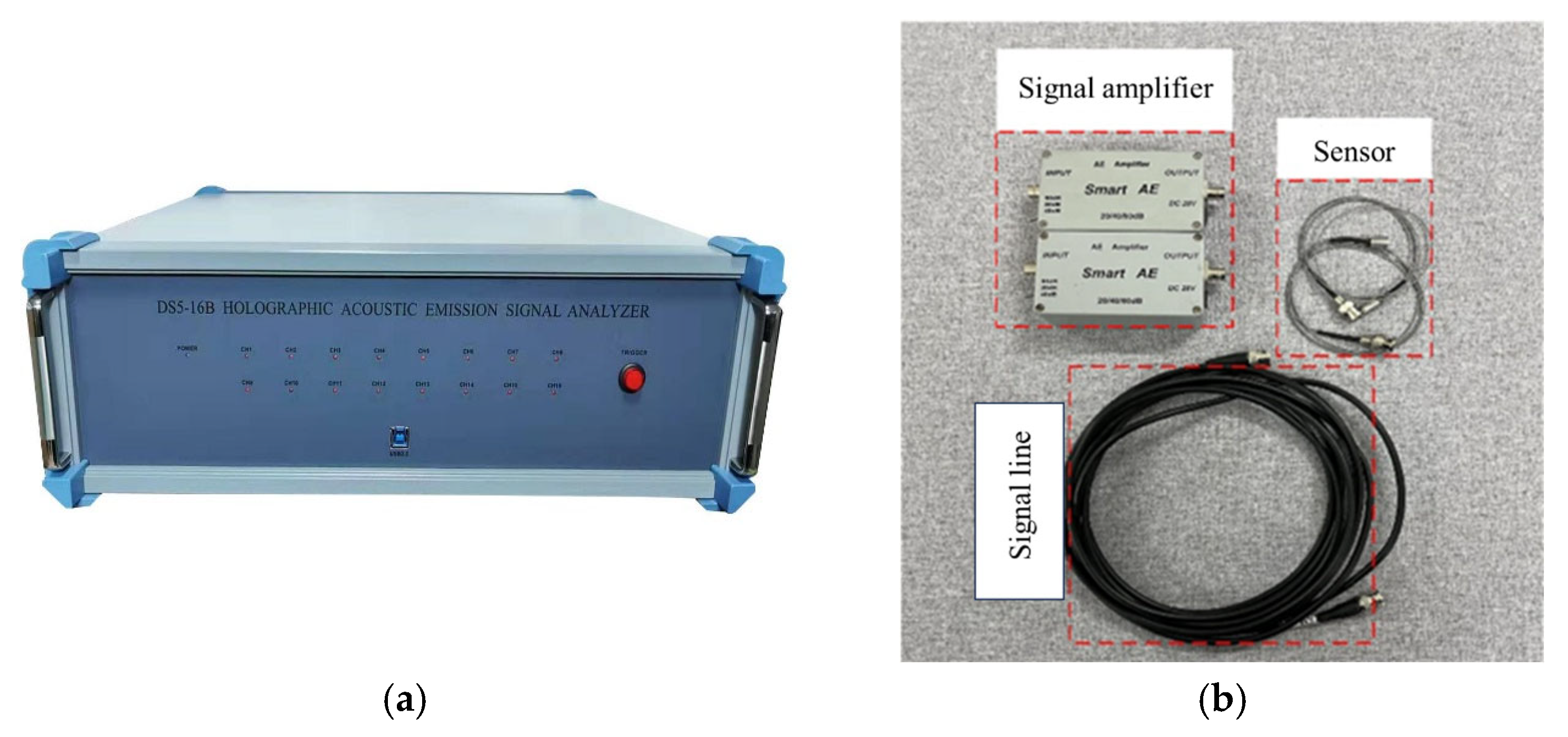

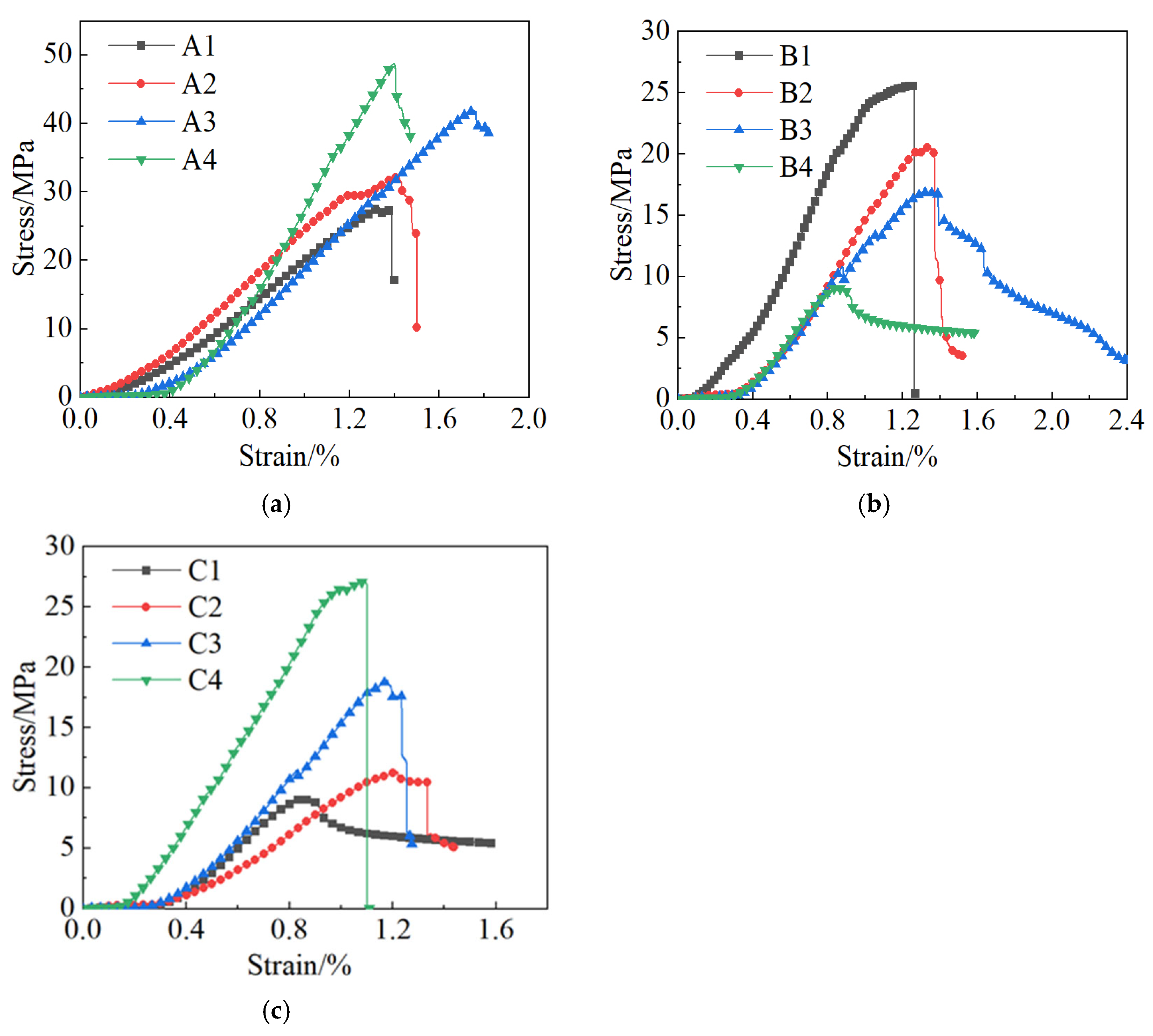
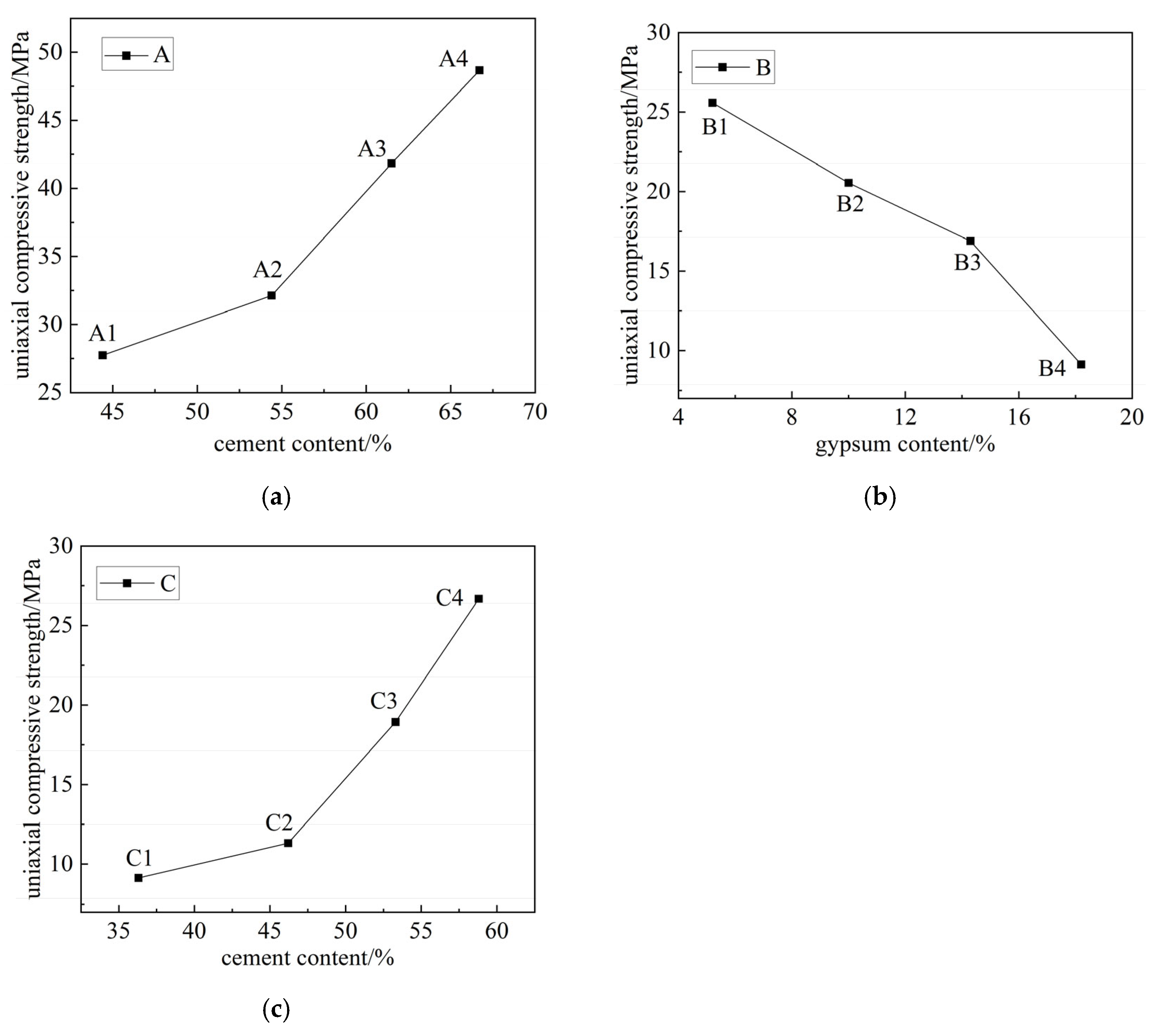

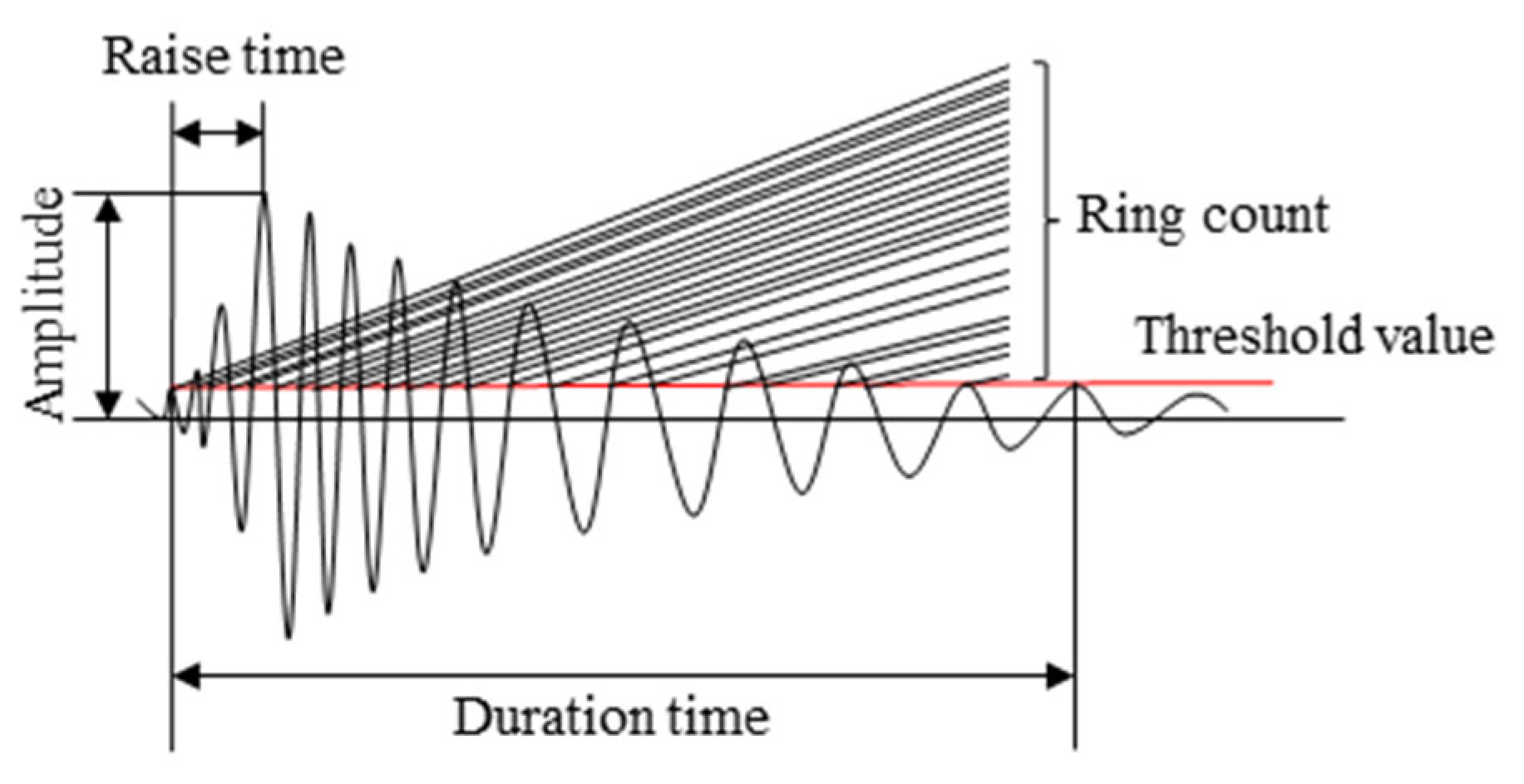
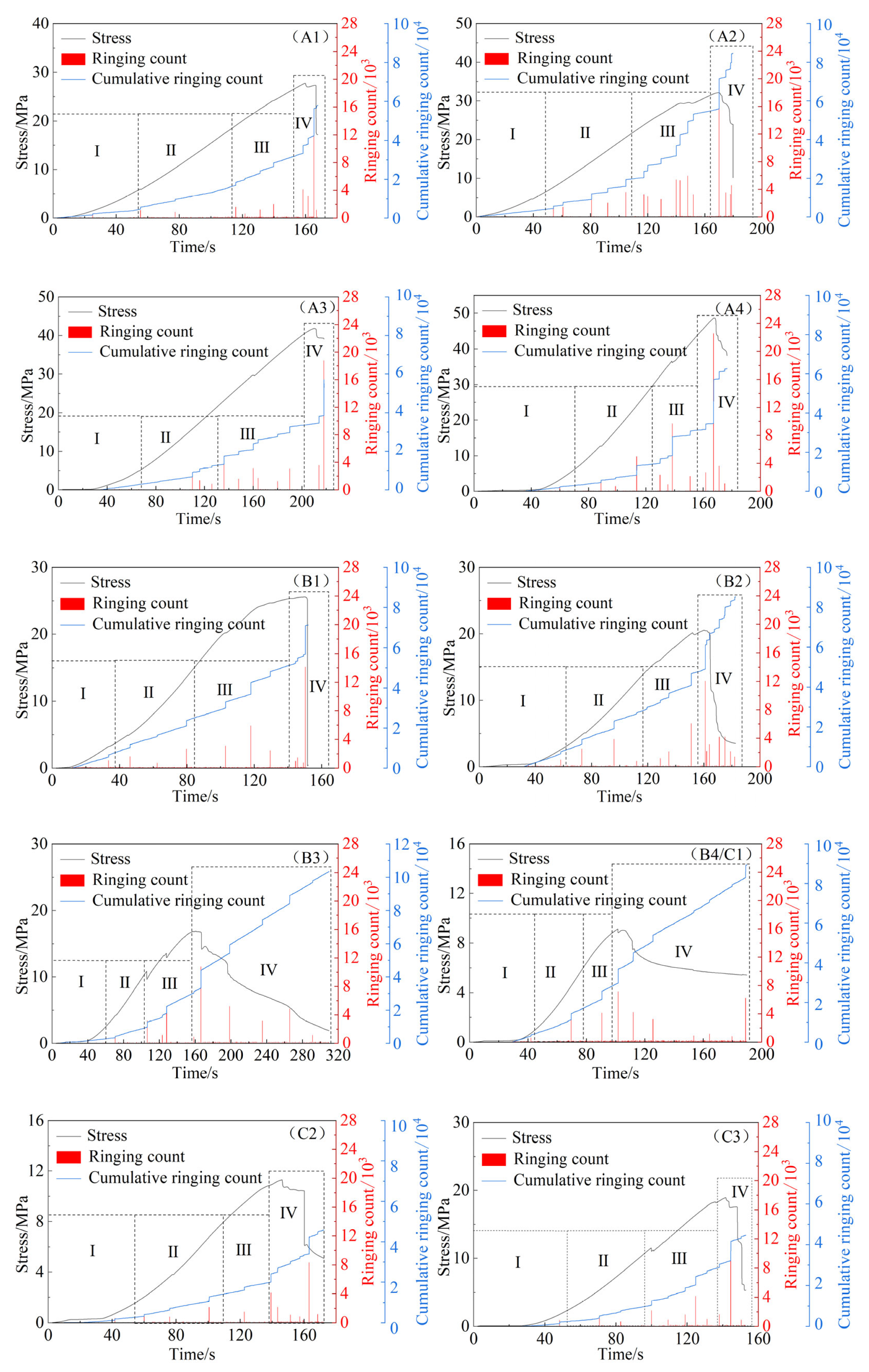
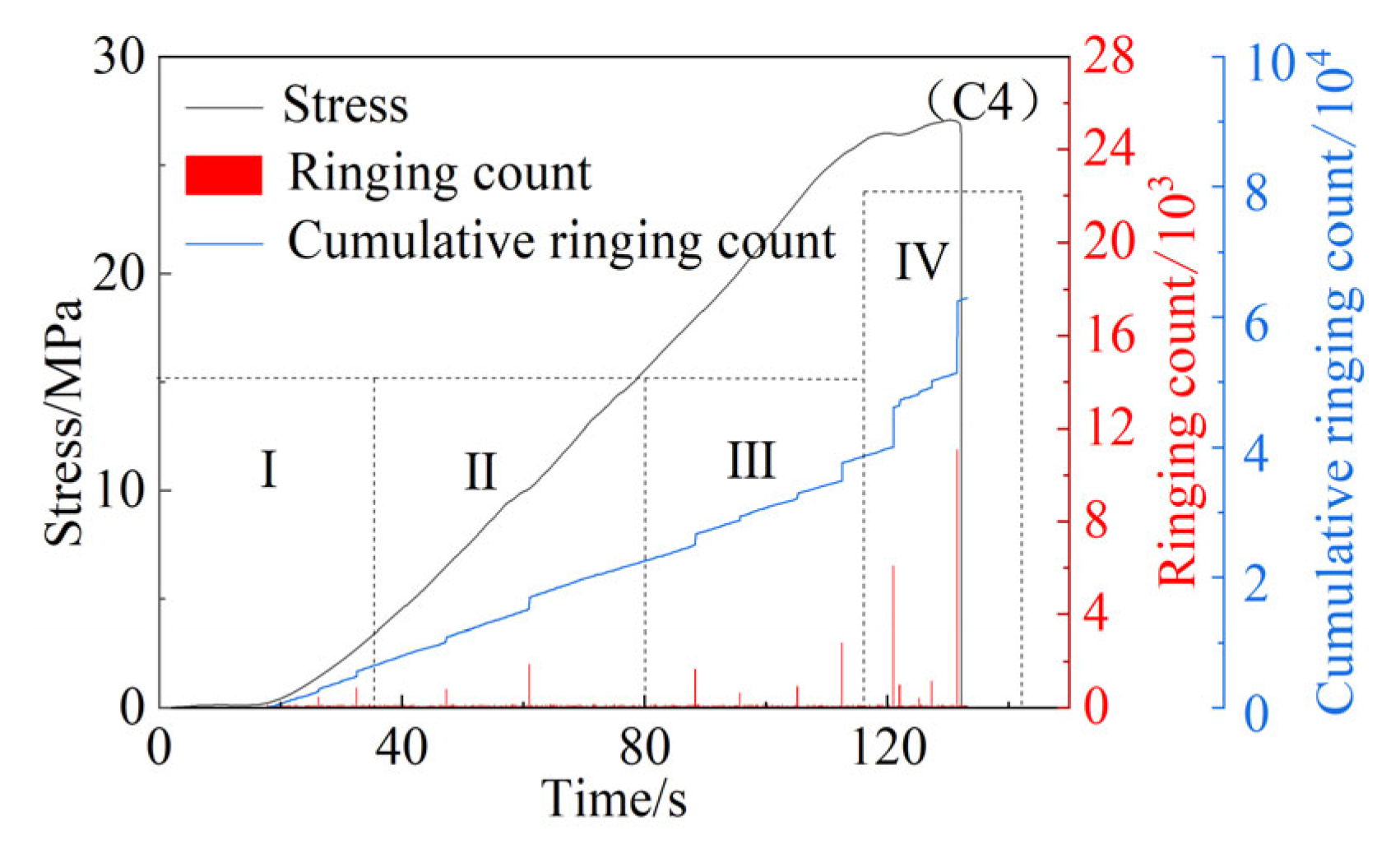
| Specimen Number | Material Mass Proportion | Specimen Mass | Specimen Density | ||
|---|---|---|---|---|---|
| Quartz Sand | Cement | Gypsum | g | g/cm3 | |
| A1 | 1 | 0.8 | 0 | 412 | 2.10 |
| A2 | 1 | 1.2 | 0 | 416 | 2.12 |
| A3 | 1 | 1.6 | 0 | 420 | 2.14 |
| A4 | 1 | 2.0 | 0 | 426 | 2.17 |
| B1 | 1 | 0.8 | 0.1 | 402 | 2.05 |
| B2 | 1 | 0.8 | 0.2 | 396 | 2.02 |
| B3 | 1 | 0.8 | 0.3 | 383 | 1.95 |
| B4(C1) | 1 | 0.8 | 0.4 | 338 | 1.72 |
| C2 | 1 | 1.2 | 0.4 | 342 | 1.74 |
| C3 | 1 | 1.6 | 0.4 | 355 | 1.81 |
| C4 | 1 | 2.0 | 0.4 | 376 | 1.92 |
| Materials | Specimen Number | Mass Proportions | Compressive Strength | Elastic Modulus |
|---|---|---|---|---|
| Quartz sand, cement | A1 | 1:0.8 | 27.74 | 2.67 |
| A2 | 1:1.2 | 32.13 | 3.03 | |
| A3 | 1:1.6 | 41.84 | 3.22 | |
| A4 | 1:2.0 | 48.67 | 5.79 | |
| Quartz sand, cement, gypsum | B1 | 1:0.8:0.1 | 25.58 | 3.47 |
| B2 | 1:0.8:0.2 | 20.55 | 2.12 | |
| B3 | 1:0.8:0.3 | 16.89 | 2.10 | |
| B4/C1 | 1:0.8:0.4 | 9.13 | 2.14 | |
| C2 | 1:1.2:0.4 | 11.32 | 1.97 | |
| C3 | 1:1.6:0.4 | 18.93 | 2.36 | |
| C4 | 1:2.0:0.4 | 26.67 | 3.32 |
| Specimen Number | Mass Proportions | The Change of Cumulative Ringing Count in Each Stage | |||
|---|---|---|---|---|---|
| I | II | III | IV | ||
| A1 | 1:0.8 | 0–7.5% | 7.5–28.3% | 28.3–55.4% | 55.4–100% |
| A2 | 1:1.2 | 0–4.8% | 4.8–23.3% | 23.3–64.8% | 64.8–100% |
| A3 | 1:1.6 | 0–5.8% | 5.8–24.6% | 24.6–63.3% | 63.3–100% |
| A4 | 1:2.0 | 0–4.9% | 4.9–22.2% | 22.2–50.5% | 50.5–100% |
| B1 | 1:0.8:0.1 | 0–10.1% | 10.1–35.4% | 35.4–67.9% | 67.9–100% |
| B2 | 1:0.8:0.2 | 0–9.7% | 9.7–33.1% | 33.1–56% | 56–100% |
| B3 | 1:0.8:0.3 | 0–3.6% | 3.6–8.6% | 8.6–28.8% | 28.8–100% |
| B4/C1 | 1:0.8:0.4 | 0–4.8% | 4.8–19.2% | 19.2–31.6% | 31.6–100% |
| C2 | 1:1.2:0.4 | 0–6.3% | 6.3–30.4% | 30.4–43.3% | 43.3–100% |
| C3 | 1:1.6:0.4 | 0–5.5% | 5.5–22.1% | 22.1–61.8% | 61.8–100% |
| C4 | 1:2.0:0.4 | 0–10.6% | 10.6–35.8% | 35.8–62.3% | 62.3–100% |
Disclaimer/Publisher’s Note: The statements, opinions and data contained in all publications are solely those of the individual author(s) and contributor(s) and not of MDPI and/or the editor(s). MDPI and/or the editor(s) disclaim responsibility for any injury to people or property resulting from any ideas, methods, instructions or products referred to in the content. |
© 2024 by the authors. Licensee MDPI, Basel, Switzerland. This article is an open access article distributed under the terms and conditions of the Creative Commons Attribution (CC BY) license (https://creativecommons.org/licenses/by/4.0/).
Share and Cite
Dai, S.; Sun, Q.; Hao, R.; Xiao, Y. Study on Failure Characteristics and Acoustic Emission Laws of Rock-like Specimens under Uniaxial Compression. Appl. Sci. 2024, 14, 8893. https://doi.org/10.3390/app14198893
Dai S, Sun Q, Hao R, Xiao Y. Study on Failure Characteristics and Acoustic Emission Laws of Rock-like Specimens under Uniaxial Compression. Applied Sciences. 2024; 14(19):8893. https://doi.org/10.3390/app14198893
Chicago/Turabian StyleDai, Shuhong, Qinglin Sun, Ruiqi Hao, and Yuxuan Xiao. 2024. "Study on Failure Characteristics and Acoustic Emission Laws of Rock-like Specimens under Uniaxial Compression" Applied Sciences 14, no. 19: 8893. https://doi.org/10.3390/app14198893





